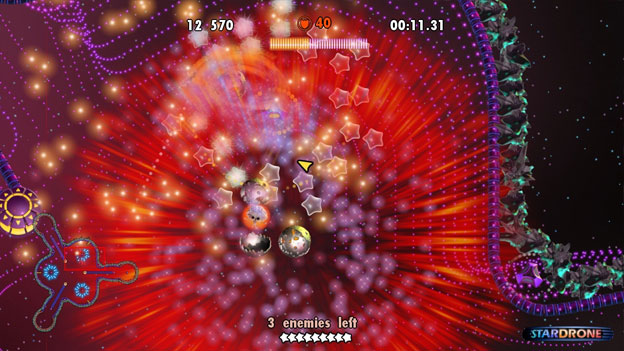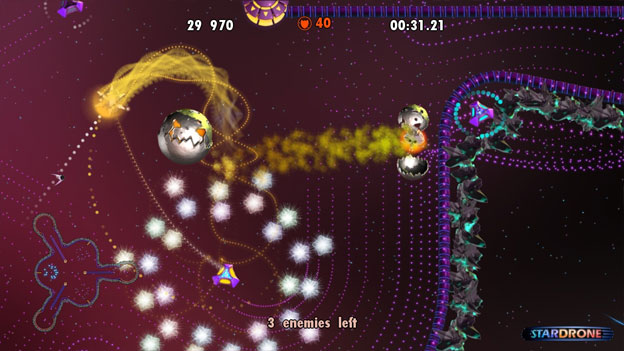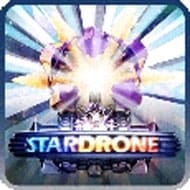Lost in Space
Maybe I just have a really dark imagination, but to me, floating free in space in a tiny little ship without boosters is a terrifying concept. Yet StarDrone takes this very idea and makes it into a lighthearted sci-fi physics puzzler with a few pinball elements tossed in.
StarDrone has players launch a small spacecraft that, by some design flaw, was built without any method of propulsion whatsoever. Instead, this thing is controlled by an electric grapple that can change the direction of the craft by latching onto nodes. Those of us who have taken courses in astronomy know that this is a horrible idea, but apparently the spacecraft builders in the world of StarDrone haven’t considered the fact that things are pretty far apart in space. I suppose you could argue that this particular craft wasn’t built for deep space travel but for short journeys amongst densely-packed asteroid fields. And to that, I have no snarky retort. But I still think that a grapple is a weird way to steer a spacecraft.

Logistics aside, there are a few issues with the controls in StarDrone. In the earlier levels, the simple control scheme feels fairly intuitive: grapple the closest node by pressing X. But in later stages, when precise timing and aim are essential, you will often find your craft grappling the wrong node, hurling you into a mass of spikes or even into deep space where you will eventually be swallowed by a black hole. (Heavy emphasis on the word “eventually.” There were a few times that I found myself floating off in space for quite some time before the black hole finally got me.) Your ship will grapple whichever node is the closest to you, no matter what. Even when it makes absolutely no sense.
However, StarDrone was originally a PC game that launched a couple years back. I tested out the PC version for myself and felt that using the mouse to select which node to grapple felt a lot more intuitive than the grapple-whatever-is-closest method that comes with using the Sixaxis. But after playing both versions of the game, I have to admit that the fact that this game was able to make the transition between such vastly different control schemes without changing any major design aspects is very impressive.

The goal of StarDrone varies with each level. Some levels have you collect a certain amount of stars, others have you collect various pieces and eventually assemble them. Some levels want you to kill a certain number of bomb-like enemies, and others require you to simply reach the end, clearly marked with a glowing goal marker.
For players with slower reflexes, there is an option to control the speed at which you play the game. Some of the control frustrations will be diminished if you adjust the game speed slider, though they won’t ever completely vanish. Strangely, I found the faster game settings to be much more comfortable, and I felt it was a lot easier to time my grapples on the fastest speed rather than the lowest.

The visuals have that science fiction vibe that a lot of 1980s arcade top-down shooters had. You know, that vibe that’s not really appealing to people who don’t care for sci-fi or even hardcore sci-fi fans, yet was still overused in video games of the 1980s. It’s not a Star Wars or Star Trek or StarCraft look, but more of a carnival in space look. In fact, it strangely reminds me of a cross between Super Mario Galaxy and the Casino Night stage of Sonic 2.
But that’s not to say that StarDrone isn’t pretty. In fact, I was quite impressed by all the comets and things darting about in the background that still never really distract you from the action. They just add a bit of visual flair without becoming obnoxious. The biggest flaw in the visuals, however, is the strange red nebula filter that shows up from time to time. I understand that something had to be done to prevent the background from looking too bland, but this effect is remarkably similar to the “Oh my gosh! I’m going to die!” effect found in many recent games such as Red Dead Redemption, Uncharted 2, the newer COD games, and so on. Upon seeing this effect in action, veterans of the shooter genre will instinctively think something is going on with their health bar.

The soundtrack of StarDrone mainly contains beat-based electronic tracks that your brain will quickly tune out. But I actually mean that as a compliment. Puzzle games need to have music that easily fades into the background. Songs that are too melody-driven or draw too much attention to themselves tend to become distracting. StarDrone’s music creates the perfect atmosphere without ever becoming annoying. And while I do realize that electronic music in space is a bit overdone (do you really think the only instruments we’ll be able to take on a spacecraft are synthesizers and drum machines?) StarDrone uses it quite well.
The sound effects are quite exaggerated: expect to hear more pinball-inspired noises than realistic spacecraft sounds or the even more realistic silence of space. This choice in audio perfectly suits the game. It makes scoring combos a lot more satisfying when there is a special combo sound that makes you feel accomplished. And I personally love the basketball sound the ship makes whenever it bounces off a metal plate.
StarDrone contains a whopping fifty-three levels, and each one has a gold, silver, and bronze medal that can be won by completing the stage within a certain time limit. While the amount of time you are given for each level feels completely random (some of the hardest levels are a lot easier to score a medal on than some of the easier levels) it gives you that extra motivation to go back and replay parts of the game. And despite the flaws with the control scheme, I actually found this a hard game to put down. The levels are short enough that they make you want to go for “just one more try” over and over. While there isn’t a whole lot you can do with a control scheme as simple as this, StarDrone manages to add new challenges and interesting twists right up until the very end. Add some trophies to the mix and, despite its flaws, StarDrone is a pretty decent value for eight dollars.
RATING OUT OF 5 RATING DESCRIPTION 3.1 Graphics
An old-school sci-fi concept with an annoying red filter that makes it feel like you are low on health even when you are not. While StarDrone’s visuals won’t blow your mind, they are actually pretty fun to look at (minus the red filter, of course). 2.5 Control
Have fun getting tossed into spikes because your ship grapples the wrong node. Over and over and over again. 3.4 Music / Sound FX / Voice Acting
The music won’t get annoying, and the sound fx actually fit the game very well. 3.5 Play Value
Fifty-three stages, each with medals to earn, make this a pretty good value for eight bucks. 3.2 Overall Rating – Fair
Not an average. See Rating legend below for a final score breakdown.
| Review Rating Legend | |||
|---|---|---|---|
| 0.1 – 1.9 = Avoid | 2.5 – 2.9 = Average | 3.5 – 3.9 = Good | 4.5 – 4.9 = Must Buy |
| 2.0 – 2.4 = Poor | 3.0 – 3.4 = Fair | 4.0 – 4.4 = Great | 5.0 = The Best |
Game Features:
